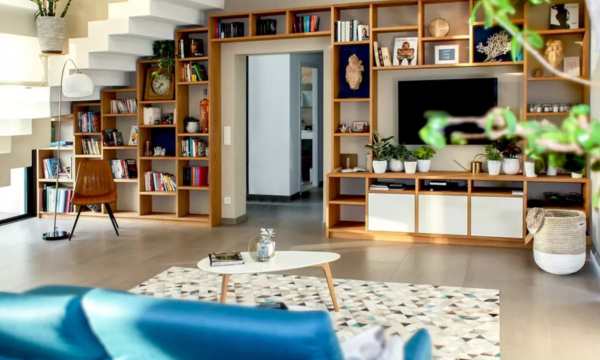With house painting, it is possible to renew the environment and give your home a unique touch.
Ad
When we think about changing the energy of a house, few things have the power of painting.
In addition to giving a completely new look, house painting renews the atmosphere and also helps preserve the walls.
Ad
And the best part? With a bit of planning and some smart tips, you can dive into this transformation yourself.
In this guide, you will find simple tricks, techniques to make the process easier, and everything you need to know to avoid the most common mistakes.
Ad
How about starting this change today?
1. Surface Preparation
Before any brushstroke, it is essential to prepare the surface.
This step is the foundation of house painting: skipping it can compromise the finish in a short time.
Start by thoroughly cleaning the area to remove dust, grease or mold.
If you find cracks or holes, apply spackle and sand the wall until it is level and smooth.
A primer may also be necessary for very absorbent walls or those that have suffered from moisture.
Paying attention to preparation ensures a more uniform, beautiful and long-lasting paint job.
2. Choosing the Right Paints
Not all paints are the same, and knowing how to choose makes all the difference in the final result!
For indoor environments, acrylic paints are the best: they dry quickly, have little odor, and are easy to clean. For outdoor areas, the paint needs to be more resistant to sun and rain.
Another important point is the finish: matte is great for hiding imperfections on surfaces, creating a softer and more elegant look.
Meanwhile, the satin finish, which is between matte and glossy, makes daily cleaning easier, making it ideal for high-traffic areas like kitchens and hallways.
And of course, always check the coverage on the package to calculate the necessary amount of paint.
This way, you avoid surprises during the process and can optimize costs, buying exactly what you need without waste.
3. Essential Tools for Efficient Painting
House painting goes much smoother when you have the right tools at hand.

Tools for efficient painting (Google Source)
Besides the traditional brushes and rollers, it is worth investing in:
- Paint trays: They help distribute the paint more efficiently, avoiding waste and ensuring a more uniform application.
- Roller extender: Perfect for reaching high areas, like the ceiling, without needing a ladder.
- Quality masking tape: Painting without it is impossible! Masking tape will protect places you don’t want to paint, like baseboards and windows.
- Brushes of different sizes: The roller is great for large surfaces, but brushes are essential for details.
- Putty knife: Before starting, the putty knife helps remove any imperfections on the surface, ensuring a smooth base ready for painting.
- Drop cloth or plastic to protect the floor: We can’t forget about protecting the floor and furniture!
4. Application Techniques: Brush, Roller or Spray
Each technique has its advantages and will depend on the type of surface and the effect you want.
Paintbrush
The brush is ideal for details and corners where the roller cannot reach. It is perfect for outlines, frames, and hard-to-reach areas, ensuring a precise finish.
Use a quality brush for a sharper and more professional result.
Roller
The roller is the favorite for covering large areas quickly and evenly. It spreads the paint efficiently, reducing working time.
If you are painting a large wall, the roller is the right choice for a smooth, streak-free finish.
Paint spray
Spray is a super practical option for those who want speed and a more modern effect. Ideal for smaller surfaces or when a thin and uniform layer is desired.
Remember to protect the environment well, as spray can spread paint in the air and cause a mess if not well controlled.
5. How to Avoid Marks and Uneven Finishes
Nothing is more frustrating than finishing house painting and noticing stains or roller marks on the wall.
To avoid this problem, here are some tricks that make all the difference:
- Avoid partial drying: Never let the paint dry partially while still painting. This can result in marks and color differences.
- Use quality brushes or rollers: Good quality tools ensure a smoother and more uniform application. Invest in brushes and rollers suitable for the type of paint and surface.
- Don’t overload the roller with paint: Avoid applying too much paint to the roller. The excess can cause dripping and unwanted marks.
- Work in well-lit environments: Good lighting helps you see imperfections better and identify areas that need more paint or touch-ups.
6. Precautions When Painting Indoor and Outdoor Areas
Outdoor areas require extra attention. Before starting, check the main precautions:
- Check the weather forecast: Make sure there is no forecast of rain or strong winds when painting outdoors.
- Choose the right paint: Use specific paints for outdoor areas, as they are more resistant to the elements.
- Protect furniture and outlets: Indoors, cover furniture and protect outlets and baseboards to avoid stains.
- Close doors and windows: This prevents dust and dirt from sticking to the fresh paint, compromising the finish.
- Ventilate the environment well: Good air circulation helps the paint dry and reduces humidity in the area.
7. Common Mistakes When Painting and How to Avoid Them
There are some mistakes that can compromise the final result of your painting.
Here’s how to avoid them:
- Skipping the primer: Primer is often overlooked, but it is essential, especially on new or highly absorbent surfaces.
- Saving on paints and tools: The temptation to save on materials is common, but it can end up costing more. Using quality paints and tools makes a huge difference in the finish and durability.
- Not calculating the amount of paint: If you don’t calculate the necessary amount of paint, you risk running out halfway through and, worse, not finding the same color to finish.
- Lack of planning: Planning the painting in advance is essential. Setting the time, tools, and even the type of paint well will prevent you from wasting time and facing problems during the job.
8. How to Prepare the Environment and Protect Furniture and Floors
Before starting to paint, it is essential to ensure that the environment is properly prepared.
Follow this simple step-by-step to protect everything properly:
- Remove or group the furniture: If possible, remove the furniture from the room or, if not possible, gather them in the center of the space and cover them with heavy-duty tarps or plastic sheets to protect them from splashes.
- Protect baseboards and switches: Use good quality masking tape to cover baseboards, switches, and door frames.
- Cover the floor: Place tarps or plastic sheets on the floor, especially if it is made of wood, porcelain or any material that stains easily.
A little care now saves you a lot of headaches later!
9. When it’s Time to Retouch the Painting and Avoid Excessive Wear
Even the best painting needs touch-ups from time to time. If you notice peeling areas, stains or fading, it’s a sign that it’s time for a refresh.
Ideally, don’t wait until the house painting becomes very worn.
Touching up small areas or renewing a wall every two or three years keeps everything looking new and preserves the structure.
10. How to Save Paint Without Compromising the Result
Saving is great, but without harming the finish, right?
- The best way to use paint efficiently is by properly preparing the surface and using the correct primer.
- Another secret is working with quality tools and following the paint dilution instructions. This way, you avoid waste and ensure perfect coverage without needing countless coats!
Ready to Renew your Home?
Now that you have all these house painting tips at hand, it’s time to get to work!
Choose the color that best suits your space, gather your materials, and transform your home with more color, protection, and personality.
Happy painting!



